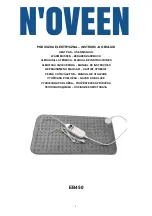
18
17
OPERATION INSTRUCTIONS
OPERATION INSTRUCTIONS
Shut Down:
1. Turn control knob clockwise to PILOT. (Normally, burner will make a slight popping sound when
extinguished.) Burner will extinguish but PILOT will remain ON.
2. To extinguish PILOT depress control knob and continue to turn it clockwise to OFF.
3. Turn cylinder valve clockwise to OFF and disconnect regulator when heater is not in use.
Note:
After use, some discoloration of the emitter screen is normal.
Operation Checklist
For a safe and pleasurable heating experience, perform this check before each use.
Before Operating:
1. I am familiar with entire owner’s manual and understand all precautions noted.
2. All components are properly assembled, intact and operable.
3. No alterations have been made.
4. All gas connections are secure and do not leak.
5. Wind velocity is below 10 mph.
6. Unit will operate at reduced efficiency below 40°F.
7. Heater is outdoors (outside any enclosure).
8. There is adequate fresh air ventilation.
When heater is ON:
The flame should be blue with straight yellow tops. If excessive yellow flame is detected, turn off
heater and consult “Troubleshooting” on page 19.
Re-lighting:
Note:
For your safety, control knob cannot be turned OFF without first
depressing control knob in PILOT position and then rotating it to OFF.
1. Turn control knob to OFF.
2. Wait at least 5 minutes, to let gas dissipate, before attempting to relight Pilot.
3. Repeat the “Lighting” steps on prior page.
WARNING
FOR YOUR SAFETY
Be careful when attempting to manually ignite this
heater. Holding in the control knob for more than 10
seconds before igniting the gas will cause a ball of
flame upon ignition.
WARNING
FOR YOUR SAFETY
Heater will be hot after use. Handle with extreme care.
CARE AND MAINTENANCE
9. Heater is away from gasoline or other flammable liquids or vapors.
10. Heater is away from windows, air intake openings, sprinklers and other water sources.
11. Heater is at least 24 in. on top and at least 36 in. on sides from combustible materials.
12. Heater is on a hard and level surface.
13. There are no signs of spider or insect nests.
14. All burner passages are clear.
15. All air circulation passages are clear.
16. Children and adults should be alerted to the hazards of high surface temperatures and
should stay away to avoid burns or clothing ignition.
17. Young children should be carefully supervised when they are in the area of the heater.
18. Clothing or other protective material should not be hung from the heater, or placed on
or near the heater.
19. Any guard or other protective device removed for servicing the heater must be replaced
prior to operating the heater.
20. Installation and repair should be done by a qualified service person. The heater should be
inspected before use and at least annually by a qualified service person.
21. More frequent cleaning may be required as necessary. It is imperative that control
compartment, burner and circulating air passageways of the heater be kept clean.
1. Gas control is in OFF position.
2. Gas Tank valve is OFF.
3. Disconnect Gas line.
After Operation
WARNING
FOR YOUR SAFETY:
• Do NOT touch or move heater for at least 45 minutes
after use.
• Reflector is hot to the touch.
• Allow reflector to cool before touching.
To enjoy years of outstanding performance from your heater, make sure you perform the following
maintenance activities on a regular basis:
Keep exterior surfaces clean.
1. Use warm soapy water for cleaning. Never use flammable or corrosive cleaning agents.
2. While cleaning your unit, be sure to keep the area around the burner and pilot assembly dry at all
times. Do not submerge the control valve assembly. If the gas control is submerged in water, do
NOT use it. It must be replaced.
a. Keep the appliance area clear and free from combustible materials, gasoline and other
flammable vapors and liquids.
b. Do not obstruct the flow of combustion and ventilation air.
c. Keep the ventilation opening(s) of the cylinder enclosure free and clear from debris.
3. Air flow must be unobstructed. Keep controls, burner, and circulating air passageways clean.
Signs of possible blockage include:






























